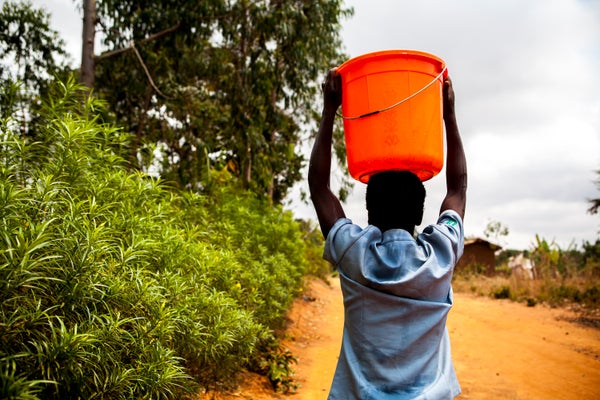This article was published in Scientific American’s former blog network and reflects the views of the author, not necessarily those of Scientific American
While global leaders gathered in New York City last month to discuss the climate crisis, it is possible that we are missing the bigger picture. It is not only a climate crisis that we have on our hands; it is a full-blown planetary emergency, and agriculture is both a source and a potential solution.
In the last year alone, African swine fever has left over five million pigs dead, fires have blazed across the Amazon to clear land for farming, devastating landslides have been triggered by intensive vegetable farming in the mountainous areas of India, and dead zones in waterways have continued to expand due in part to agricultural runoffs. Let us not forget the dangerous declines in biodiversity driven largely by agriculture, as reported in a landmark intergovernmental report this year.
These are happening in addition to and not just as a cause of climate change and yet will most certainly make the impacts of climate change far worse.
On supporting science journalism
If you're enjoying this article, consider supporting our award-winning journalism by subscribing. By purchasing a subscription you are helping to ensure the future of impactful stories about the discoveries and ideas shaping our world today.
So, the decisions made in the next few decades will have huge ramifications for the future of our planet, and getting our food systems right is at the heart of this. Current practices are contributing to the problem, all in an effort to produce the record amounts of food needed to feed our global population.
But can agriculture accomplish this, admittedly massive, task while reducing its negative impacts at the same time?
The Green Revolution enabled food production to outpace population increases, but it was this very progress that contributed to large-scale land and water degradation, biodiversity losses and increased greenhouse gas emissions.
Now, the productivity of 23 per cent of global land has declined, and about 75 percent of freshwater is used just for agriculture.
Even if the climate crisis was miraculously solved tomorrow, agricultural production would still be racing down the road to unsustainability—failing to deliver diverse diets for all, income equality or the health and well-being of the world’s forests, soils and water.
Currently, so-called solutions are often heralded as the solution to climate change—from planting millions of trees or sequestering carbon in farms. But placing all bets on any one of these alone will not resolve the myriad challenges facing the agriculture sector and those whose livelihoods depend on it.
So, what will?
We need a radical transformation of food production, and we already know a lot about how to make this happen.
The first step is to face the reality that agriculture must be intertwined with preserving and restoring natural resources such as water, land, ecosystems and biodiversity of plants and animals, a practice known as sustainable natural resource management (NRM).
NRM demands better understanding and examining of how agricultural practices affect these resources wherever possible, whether positively or negatively. For instance, what effects do new irrigation systems (which benefit farmers) have on wetland systems, biodiversity and the availability of drinking water for nearby cities?
The second step is to actively manage the various trade-offs and synergies that exist between agricultural growth and the environment. Policies that promote diverse diets, for instance, can enrich soils and build biodiversity through the introduction of alternative crops or forgotten foods, but they may mean convincing people accustomed to other foods to eat them. Knorr, for instance, is collaborating with Sodexo and World Wildlife Fund–U.K. to introduce ancient ingredients into products as a way of enhancing diversity.
Other agricultural innovations, such as solar irrigation technology, are helping to build positive environmental outcomes while countering potential risks. Yes, it is a climate solution: replacing carbon-inefficient diesel pumps. But it also helps farmers access ever-scarcer water resources and endure periods of extreme drought. While “free” solar electricity may lead to overpumping of groundwater, new models incentivize farmers to sell excess electricity to the grid instead.
Thirdly, encouraging and investing in future solutions that tackle these multiple complexities at once will help deliver more food in ways that nourish both people and the environment. This is not a zero-sum game.
But we also know that overcoming barriers to political and institutional apathy, vested interests, up-front costs of innovations and insufficient investment in the right type research and development is a critical aspect of this effort also—and that change in these areas is difficult and slow.
That is why we are establishing a Commission on Sustainable Agriculture Intensification, which will look at the key barriers to change by bringing together eminent scientists, policy-makers, business leaders, farmer organizations and others to gather and critically assess the best solutions, technologies and—most importantly—incentives that will drive change.
Results from this two-year-long process will provide the evidence, recommendations and engagement needed to build a roadmap that can bring about this transformation. It is no wonder, then, that the recent Global Commission on Adaptation report calls to double funding for agricultural research through the global research partnership CGIAR.
Solutions such as these will help the world, particularly those in the most vulnerable areas of the global South. to deliver more food sustainably, while building environmental health and climate resilience.
After all, it is our natural resource base that will keep humanity alive and thriving in the long term. Our food systems need to reflect this. Let us not just fulfil short-term needs that place our long-term food security at stake.
